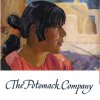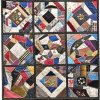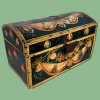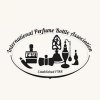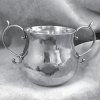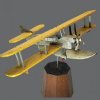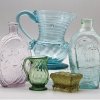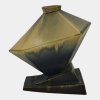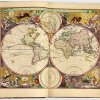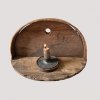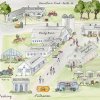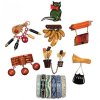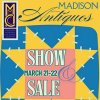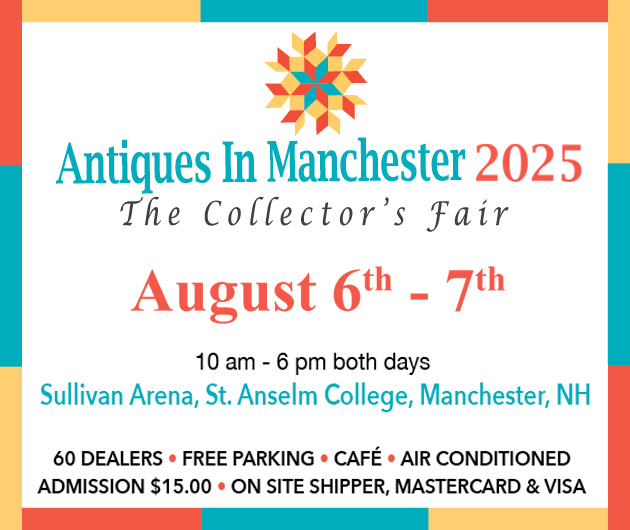The 2017 Philadelphia Antiques & Art Show
April 20th, 2017
Philadelphia, Pennsylvania
The Philadelphia Antiques & Art Show is alive and well. It has been resuscitated by the management team of Diana Bittel and Karen DiSaia, working with volunteers led by Anne Hamilton, Nancy Kneeland, and Nancy Taylor. They made certain that the right dealers exhibited and the right people came to buy and support Penn Medicine, the beneficiary of the show.

The purpose-built tent kept 60 dealers dry on a rainy weekend.
Collector Jay Stiefel and advisor-agents Alan Miller, Luke Beckerdite, and Bill Stahl were at the front of the line waiting for admission to the 5 p.m. preview on Thursday, April 20. A few other very private collectors, some with an advisor in tow, were not far behind. They looked carefully and bought. Many who came socialized with old friends and then regretted that they did not take time to see all that was for sale.
By Friday night, the end of the first full day, a good number of sales had been made, and by Sunday there were even more. A rainy Saturday brought out a buying crowd, but with gorgeous weather on Sunday, there was smaller attendance. It was a shame that the crowds who came to Philadelphia for the opening of the new Museum of the American Revolution that same weekend were not bused to the antiques show, but an agreement to run a shuttle bus between the two venues, just five miles apart, could not be reached.
Half a dozen dealers said sales were very good. Others said business was OK, and some said that despite many sales, they did not make expenses because collectors did not buy their most expensive pieces. One dealer said he made four sales during the show, one on Facebook, two on Instagram, and one on his website. But didn’t the fact that he was at the show compel those buyers to make up their minds and spring for what they wanted before it was too late?
Antiques shows serve many purposes: selling, advertising, meeting new clients, educating, and camaraderie. Dealers and collectors look forward to seeing each other. They wouldn’t miss the Philadelphia show for the world. There was a good amount of dealer-to-dealer selling at this show.
As for education, York County dealer Jeff Bridgman borrowed the best American flags that he had sold over the years for a stunning, large loan exhibition. He gave a memorable gallery talk about them on Sunday afternoon to a few dozen people, imparting his passion for history revealed in the designs of the Stars and Stripes. He also wrote a long article for the show catalog on “The Evolution of the Design of the American National Flag: From 1767-1912, as It Relates to Collecting Antique Examples.”
On Saturday night, new collectors were fortified by “Colonial spirits,” and there was a book signing for a new book by Philadelphia ad man and distiller Steven Grasse. It has a long title: Colonial Spirits: A Toast to Our Drunken History, Being a Revolutionary Drinking Guide to Brewing and Batching, Mixing and Serving, Imbibing and Jibing, Fighting and Freedom in the Ruins of the Ancient Civilization Known as America. Grasse is the man behind such brands as Hendrick’s Gin, Narragansett Beer, Sailor Jerry Spiced Rum, and QC Malt, and Tamworth Distilling.
Tamworth Distilling, his latest project, nestled in the hills of the White Mountains in New Hampshire, focuses on a time when farmers experimented with distillation and turned their leftover grain into whiskey. Grasse has begun to build a community where seasonal spirits are distilled, adding local crops such as blueberries, mushrooms, wildflowers, and honey and using 19th-century fermentation techniques as well as cutting-edge machines like sonic emulsifiers.
Grasse lives in the Society Hill section of Philadelphia. Nancy Kneeland and Anne Hamilton got the idea of inviting young people to the show to meet Grasse, try his sprits, and go on an antiques treasure hunt. Anyone who could find an object that looked like Kim Kardashian’s derriere got a prize. It got everyone to look into every booth, and two people won. They found the coco de mer, the largest seed pod in the world, which grows only on the Seychelles islands. It was on Steven S. Powers’s stand. According to the wall label, sailors would find these big pods floating in the ocean in the 1880s and collect them for their female shape. Powers asked $3400 for the sexy 13" tall sculptural objet trouvé.

Steven S. Powers of Brooklyn, New York, offered the Marshalltown Menagerie, more than 90 wood carvings of animals decorated with paint and some with thorns and leaves, by an anonymous carver in Marshalltown, Iowa, circa 1930. The average size of the animals is 2½" high x 4" long, and the display is 58" high x 38" wide. It was acquired by Calvin White in lieu of payment and remained in the White family for 80 years. The wildest carving is a sea creature; the most complex is the circus cart with a monkey and a snake on top, pulled by two giraffes. The group calls to mind the Noah’s arks made in Germany, but these animals are not in pairs. Each animal seems to have its own personality. The menagerie was priced at $39,500, and it sold.
What an ingenious idea to introduce new collectors to the show and get them into every booth! About 100 people bought tickets for the event at $50 each and heard the Orpheus Club sing, while sipping Grasse’s daring artisanal spirits and experiencing an antiques show.
“We only announced this event with an e-mail blast to a select list,” said Nancy Kneeland. “It was an experiment, and it worked. It was fun, and it will be offered again next year. We hope to get even more new faces. Steven Grasse is a Philadelphia treasure, a big draw, and Colonial spirits, a perfect fit for the antiques show.”
Colonial furniture was front and center, and a lot of it sold. Philip Bradley sold a chest made for Maria Elizabeth Weber that was decorated with birds and mermaids, dogs chasing a stag, a horse, and tulips at the corners and with Maria Elizabeth Weber’s name and the date 1773. When it sold at Pook & Pook’s sale of Mr. and Mrs. Donald Shelley’s collection in 2007, it had not been attributed to Friedrich Speyer from the Ephrata area.

Skip Chalfant of West Chester, Pennsylvania, sold the Chester County candlestand in the foreground at the preview. The Philadelphia mahogany chair on the right with a relief-carved Gothic splat, circa 1775, was $5800; the Philadelphia mahogany chair to the left with multiple shells, fluted stiles, a strapwork splat, and great patina, 1760-75, was $18,500.
Two candlestands sold early at the preview. James Kilvington sold the Philadelphia stand he bought at the Margaret and E. Newbold Smith sale at Sotheby’s in January and advertised it in the catalog as “Philadelphia Perfection.”
By the end of the show, Skip Chalfant had sold a Chester County stand with a quirky turned pedestal, two pairs of chairs, two weathervanes, two paintings, two Kentucky rifles, a pair of pistols, and a William and Mary chest.
By Friday Arthur Liverant had red sold stickers covering the prices of a Rhode Island dressing table and a Queen Anne side chair made for Mary Fish when she married the Reverend John Noyes in 1758. They came down in the Silliman family and were fresh to market. Liverant also sold a worktable painted by Sarah Leavitt when she was at a school in Northampton, Massachusetts. He discovered her name and “Northampton” written in pencil on the back of the table.
Taylor Thistlethwaite, a young Kentucky dealer showing in Philadelphia for the first time, sold a marble-top Baltimore table with a profusion of leafy inlay, a Virginia sofa, a chest-on-chest, two paintings, a large feather-edge platter, and a pair of Philadelphia andirons of the highest quality.
New Yorker Frank Levy sold a sideboard inlaid with daffodils, possibly Baltimore and maybe made farther south, knife boxes that were on it, a pair of Queen Anne chairs, a Pembroke table, a mocha pitcher, and a transferware pitcher with a portrait of George Washington and an American eagle under the spout with the words “Republicans Are Not Always Ungrateful.”
James and Nancy Glazer sold two sack-back Windsor chairs in original paint, a fraktur, several small folk paintings, and more. Christopher Rebollo found buyers for a double portrait of two girls and a triple portrait of three boys by Joseph Whiting Stock, a Federal linen press, and a New York marble-top pier table. Peter Eaton found buyers for three chairs, two sides and a Carver chair, a desk, a fireboard, some candlesticks, and paintings. Jeffrey Tillou wrapped up a view of the waterworks on the Schuylkill, and he was seen writing up slips every day.

Lori Cohen, director of Arader Galleries in Philadelphia, asked $650,000 for An East Prospect of the City of Philadelphia by George Heap and Nicholas Scull, engraved by Gerard Vandergucht, London, 1754. The four sheets together measure 20 1/8" x 80 1/8". The view is the earliest engraved panoramic view of Philadelphia. Thomas Penn, son of William Penn, the founder of the colony, requested a view of the city as an advertisement to attract more entrepreneurs, merchants, and settlers to the city. George Heap drew it from the New Jersey side of the Delaware, but he died before the project was completed, and Nicholas Scull, the surveyor of the province, entrusted the drawing to Vandergucht for engraving. The scene shows a bustling waterfront, and the Penn coat of arms is on the bottom of sheet three. The initial press run was 500, followed by a second run of 250. Six copies exist in American institutions. Arader photo.

The Connecticut River valley tiger maple secretary, circa 1775, was $32,500 from dealer and show manager Diana Bittel of Bryn Mawr, Pennsylvania. A pair of cast zinc lions (one shown), with a J.W. Fiske label, circa 1880, 46" x 18", was $19,500.
Art dealers as well as furniture dealers sold paintings. Robert Schwarz sold his Charles Peale Polk portrait of Edger Patterson, a prominent businessman and merchant in Georgetown in the District of Columbia and the builder of grist mills along the Potomac at Little Falls Bridge.
Amy Finkel said she had a very good show, selling three of the four samplers on her center wall and more than half a dozen from the side walls as well as a blanket chest to clients, some of whom came to Philadelphia from out of town to attend the show.
This is only a random sample of sales. The pictures and captions tell more. It seems as if the tide has turned; lower prices have put sales on an uptick. But not everyone sold briskly. As always there were great things left when the show closed at 5 p.m. on Sunday afternoon.

Olde Hope Antiques, New Hope, Pennsylvania, offered this rare carousel rooster from the Dentzel Company, Philadelphia, 1900-20, 51" high x 56" wide, for $125,000.

This carved and gilded Classical mahogany period sofa with eagle-head feet, attributed to Isaac Vose & Son, Boston, was made for export to Charleston, South Carolina, circa 1820. It was tagged $45,000 by Christopher T. Rebollo of North Wales, Pennsylvania. It retains labels that show it was made for export to the Charleston District of South Carolina. The double portrait of two sisters behind it, probably Philadelphia, 1835-40, 36" x 30", was $7500.
After every show, one memorable object stays in your mind. At this show, it was the redware jar probably made in Maine 1820-40, which Sam Herrup said was the finest piece of redware he has ever owned.
Antiques shows face huge competition for collectors’ dollars from the Internet and the auction rooms. Dealing in antiques is not an easy road to riches, but there are rewards in finding, owning, showing, and selling superior works from the past. Moreover, the antiques world is a pleasant escape from our troubled times.
For more information, go to (www.philadelphiaantiquesandartshow.com).
Patricia Kane Receives Award of Merit
On Friday, April 21, after the Philadelphia show closed, Patricia E. Kane, the Friends of American Art Curator of American Decorative Arts at the Yale University Art Gallery, received the Award of Merit from the Antiques Dealers’ Association in the form of a Newport corkscrew finial made especially for her. (Dealer Arthur Liverant, who made the presentation, said he could not give her the traditional Philadelphia flame finial that other recipients have received.)
 Two of Kane’s former associate curators, David Barquist and John Stuart Gordon, Barquist’s replacement when he became curator of decorative arts at the Philadelphia Museum of Art, gave a witty roast and showed pictures of Kane holding discussions on connoisseurship with Joe Kindig III, even while vacationing on St. Barts, and wearing a yellow hazmat suit to retrieve American furniture from infested storage at Yale.
Two of Kane’s former associate curators, David Barquist and John Stuart Gordon, Barquist’s replacement when he became curator of decorative arts at the Philadelphia Museum of Art, gave a witty roast and showed pictures of Kane holding discussions on connoisseurship with Joe Kindig III, even while vacationing on St. Barts, and wearing a yellow hazmat suit to retrieve American furniture from infested storage at Yale.
In her acceptance speech Kane spoke of the importance of dealers to scholarship and connoisseurship, pointing out that her mentor Charles Montgomery (1910-1978), the director of Winterthur before he became the curator of American decorative arts at Yale, was a pewter dealer before he went on to his museum and academic career.
“Nothing opens the purse or closes the eye so quickly as the desire to get a great bargain” was a Montgomery remark that Kane said she never forgot. Then she paraphrased Montgomery by saying, “Most bargains crowd the shelves with objects not so good as they ought to be, either in terms of quality or condition. Whereas in the joy of a treasure one soon forgets a high price paid, in the possession of the second-rate, one remembers only its cheapness.”
She ended with a Montgomery aphorism, “When you acquire a thing with an alteration or restoration, every time you look at it that is always the first place your eye goes.”
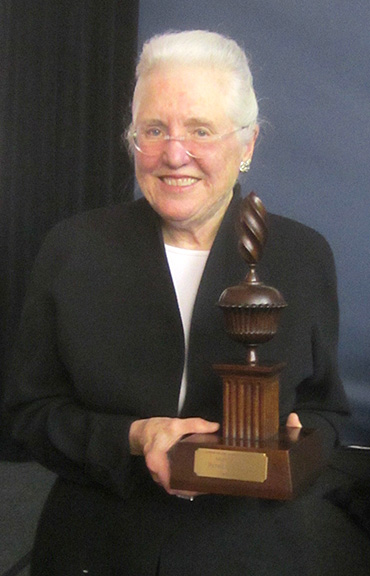
Patricia Kane, Friends of American Art Curator of American Decorative Arts at the Yale University Art Gallery, received the ADA 2017 Award of Merit on April 21 at a dinner at the Philadelphia Antiques & Art Show. A special Newport corkscrew finial was turned to present to her. It replaced the traditional Philadelphia flame finial that was given to the previous 16 recipients since the award was initiated in 2002. David Barquist and John Stuart Gordon, who have worked as her associate curators, gave a humorous roast.
Originally published in the June 2017 issue of Maine Antique Digest. © 2017 Maine Antique Digest
